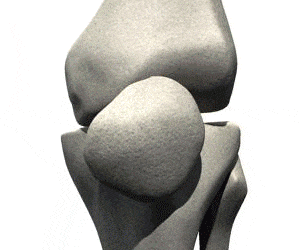Our interactive 3D knee diagram is an informative 360 degree rotating model. Each of the 6 sections (Bones, Connective Tissue 1, Connective Tissue 2, Deep Muscles, Muscles & Skin) can be opened up, rotated left or right and viewed more closely.
Furthermore, there are several individualized parts of the knee within each sub section that comes with important information about its appropriate knee function. Enjoy the knee diagram!
Click on bones, joints, veins, muscles, and other knee parts to view detailed information about each!
Interactive 3D Knee Diagram
The knee is a complex joint that has many functions. It bends back and forth and twists minimally from side to side.
The knee connects the thigh bone (femur located in the upper leg) to the shinebone (tibia located in the lower leg. The calf bone (fibula located in the lower leg) connects to the joint, but is not directly affected by the hinge joint action. The kneecap (patella located in the middle of the knee) is the center bone.
The menisci which are 2 concave pads of cartilaginous tissue serve to disperse friction created by the tibia and femur.
The 4 key ligaments of the knee are:
- Anterior cruciate ligament (ACL) – stabilizes front-back knee movements & can be sprained or torn if the knee is hyperextended, twisted or bent. It’s a common sports injury that occurs when there is a hard stop or twisting of the knee.
- Medial collateral ligament (MCL) – supports side to side movements & can become injured when there’s a pushing force on the outside of the knee inward.
- Lateral collateral ligament (LCL) – also supports side to side movements and can become injured when there is a pushing force on the inside of the knee outward.
- Posterior cruciate ligament (PCL) – also stabilizes front-back knee movements & is an injury that’s the least common in the 4 ligaments.
Find out more about knee anatomy and knee muscles! Both are helpful in understanding where your knee pain may be coming from or what caused it.
You should also go through our Knee Pain Diagnosis article for an easy 10-step guide to diagnosing knee issues. Understanding the causes and conditions is the first step to getting rid of knee pain.


